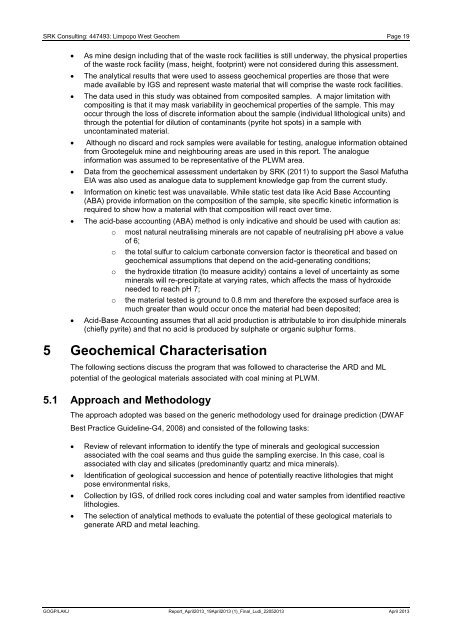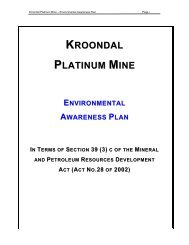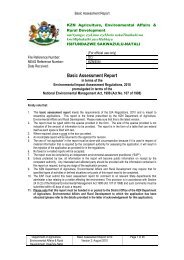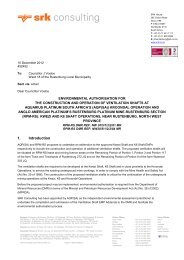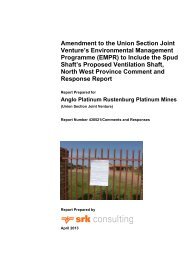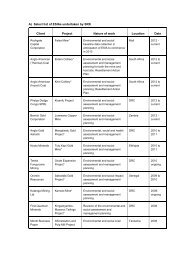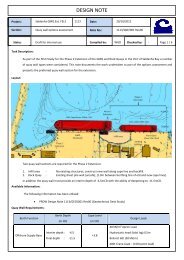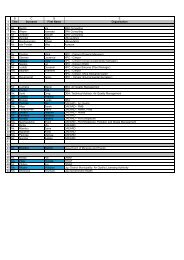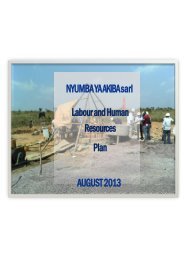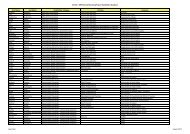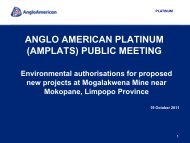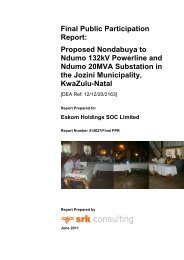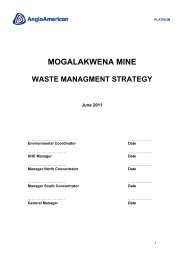Proposed Limpopo West Mine Concept Study ... - SRK Consulting
Proposed Limpopo West Mine Concept Study ... - SRK Consulting
Proposed Limpopo West Mine Concept Study ... - SRK Consulting
Create successful ePaper yourself
Turn your PDF publications into a flip-book with our unique Google optimized e-Paper software.
<strong>SRK</strong> <strong>Consulting</strong>: 447493: <strong>Limpopo</strong> <strong>West</strong> Geochem Page 19As mine design including that of the waste rock facilities is still underway, the physical propertiesof the waste rock facility (mass, height, footprint) were not considered during this assessment.The analytical results that were used to assess geochemical properties are those that weremade available by IGS and represent waste material that will comprise the waste rock facilities.The data used in this study was obtained from composited samples. A major limitation withcompositing is that it may mask variability in geochemical properties of the sample. This mayoccur through the loss of discrete information about the sample (individual lithological units) andthrough the potential for dilution of contaminants (pyrite hot spots) in a sample withuncontaminated material.Although no discard and rock samples were available for testing, analogue information obtainedfrom Grootegeluk mine and neighbouring areas are used in this report. The analogueinformation was assumed to be representative of the PLWM area.Data from the geochemical assessment undertaken by <strong>SRK</strong> (2011) to support the Sasol MafuthaEIA was also used as analogue data to supplement knowledge gap from the current study.Information on kinetic test was unavailable. While static test data like Acid Base Accounting(ABA) provide information on the composition of the sample, site specific kinetic information isrequired to show how a material with that composition will react over time.The acid-base accounting (ABA) method is only indicative and should be used with caution as:o most natural neutralising minerals are not capable of neutralising pH above a valueof 6;ooothe total sulfur to calcium carbonate conversion factor is theoretical and based ongeochemical assumptions that depend on the acid-generating conditions;the hydroxide titration (to measure acidity) contains a level of uncertainty as someminerals will re-precipitate at varying rates, which affects the mass of hydroxideneeded to reach pH 7;the material tested is ground to 0.8 mm and therefore the exposed surface area ismuch greater than would occur once the material had been deposited;Acid-Base Accounting assumes that all acid production is attributable to iron disulphide minerals(chiefly pyrite) and that no acid is produced by sulphate or organic sulphur forms.5 Geochemical CharacterisationThe following sections discuss the program that was followed to characterise the ARD and MLpotential of the geological materials associated with coal mining at PLWM.5.1 Approach and MethodologyThe approach adopted was based on the generic methodology used for drainage prediction (DWAFBest Practice Guideline-G4, 2008) and consisted of the following tasks:Review of relevant information to identify the type of minerals and geological successionassociated with the coal seams and thus guide the sampling exercise. In this case, coal isassociated with clay and silicates (predominantly quartz and mica minerals).Identification of geological succession and hence of potentially reactive lithologies that mightpose environmental risks,Collection by IGS, of drilled rock cores including coal and water samples from identified reactivelithologies.The selection of analytical methods to evaluate the potential of these geological materials togenerate ARD and metal leaching.GOGP/LAKJ Report_April2013_19April2013 (1)_Final_Ludi_22052013 April 2013


